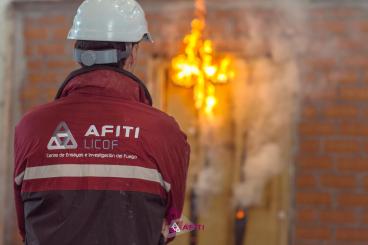

How to Check the Resistance of a Fire Door
For an automatic door to be effective fire barrier, and to be able to prove it is, it needs to meet one indispensable requirement: to have been accredited by relevant tests and evaluations by a specialised laboratory. Experts from AFITI, Tecnifuego, Mecosa and Padilla explain the process.
Fire-resistant doors cannot be considered as such until they have been tested in the laboratory, says Magdalena Villegas, Technical Manager of Technology Services at AFITI (Spanish Association for the Promotion of Research and Fire Safety Technology). She warns that the door to be tested and the fire laboratory must be selected with great care. “The door should cover the maximum field of application, taking into account possible future configurations. Communication between the manufacturer and the laboratory should be agile so that the latter presents the best option from the technical and economic point of view.”
The laboratory must be appropriately accredited, but this requirement alone may not be sufficient. Villegas says, “depending on the reason for the test and where you intend to market the door, you may need to involve certification or notification bodies.” For this reason, before carrying out the tests, “you have to identify your market, to determine the regulatory requirements. Then you can decide which bodies to involve and, depending on that choice, the most suitable laboratory.”
Main Requirements
José Vicente Andreu is Coordinator of the Fire Doors Group at TECNIFUEGO (Spanish Association of Fire Protection Companies). He lists all the requirements that a door must meet in order to be considered a fire door: First of all, “it has to be fire-resistant, complying with all applicable regulations on fire resistance and self-closing durability tests with the CE mark on its fittings and components, and the CE mark on the door itself.” Secondly, “it has to be installed correctly, according to the field of application of its tests and the scope of its CE mark, following the manufacturer’s instructions.”
Furthermore, “it mustn’t have any fittings or parts not included in the field of application of the tests and the scope of its CE mark. It must be in good condition for use and maintenance applying the UNE 23740-1 standard.” Since the update to the Spanish Technical Building Code, Document DB-SI2, published 24th September 2020, the mandatory standard is UNE 23740-1:2016 Fire Safety. Gap Covering Components. Specific requirements for installation, use, maintenance. Part 1: Fire Doors.
If it complies with all of the above, the fire door complies with the requirements that it “can be easily opened if it is on an escape route; and stay closed during contact with the fire.”
Raising Awareness Among Manufacturers
Manufacturers stress the critical and decisive role played by fire doors in the facilities where they are installed. Lorenzo J. Parejo, Marketing Manager at Puertas Padilla, explains that they are used for fire safety, and their primary function is to create separate sectors and compartmentalise areas in different kinds of buildings in a variety of industries. “There are different fire resistance ratings, measured in minutes. These are technical doors with a rigorous performance test employing fire tests carried out by specialist approved laboratories.”
Noelia Vela, Quality Manager with Metaloconstrucciones Mecosa, emphasises that fire doors must have documentation that accredits that they have been subjected to the relevant tests and evaluations. She also explains that sliding fire doors, and vertical doors, in particular, must resist fire under the integrity and thermal insulation characteristics detailed in product standard UNE EN 13501-2:2019.
That standard states that “doors must pass tests that take into account the intended scope of application of the product. That is, not only the required fire resistance time but also where they are going to be installed.”
Regards door classification, she says that the “I” refers to integrity, which specifies “how long the door can prevent the passage of flames and hot gases from one side of the door to the other, due to the passage of flames or very hot gases” The “E” refers to thermal insulation, which is “the ability to withstand exposure to fire on one side only, without transmitting the fire to the other side due to significant heat transfer.”





